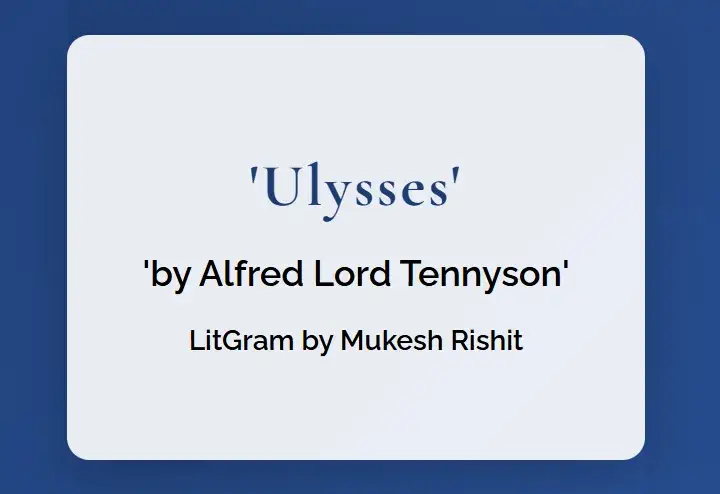“To strive, to seek, to find, and not to yield” – these enduring words from Alfred Lord Tennyson’s “Ulysses” have resonated through the ages motivating many readers to chase their dreams despite life’s hurdles. This masterwork released in 1842, remains one of the most praised poems in English literature. It blends classical mythology with Victorian values to create a lasting reflection on purpose, growing older, and the unbreakable human spirit.
II. The Poet Behind the Poem
Alfred Lord Tennyson (1809-1892) penned “Ulysses” during a tough time in his life. As Britain’s Poet Laureate and one of the Victorian era’s most popular writers, Tennyson had a knack for literary greatness. Yet, the creation of “Ulysses” was close to his heart written after his close friend Arthur Hallam died in 1833.
Tennyson’s life echoed some of the themes in “Ulysses” – the battle between duty and desire, the search for meaning, and the resolve to move forward despite loss. His selection as Poet Laureate in 1850 happened after years of personal challenges and growth as a writer, which made him sensitive to the intricacies of obligation and personal goals that he delved into in the poem.
III. Historical Context
The Victorian age brought unparalleled change and progress. The Industrial Revolution was at its peak scientific breakthroughs challenged old beliefs, and Britain’s empire grew across the world. This setting provided the ideal backdrop to write about exploration, the pursuit of knowledge, and the conflict between home responsibilities and the urge to adventure.
IV. The Birth of “Ulysses”
Tennyson wrote “Ulysses” in 1833 but didn’t publish it until 1842. The poem came from his sadness over the death of Arthur Hallam. Tennyson used the poem’s themes of not giving up and looking for a purpose to help him deal with his loss and find meaning in keeping on with life. The character Ulysses was just right to explore these deep feelings and thoughts.
V. Breaking Down the Literature
A. How It’s Built and Shaped
“Ulysses” uses blank verse – unrhymed iambic pentameter – which gives it a natural, speech-like flow while keeping its poetic grace. The poem takes shape as a dramatic monologue letting readers dive straight into Ulysses’ thoughts and drives. This setup creates a close bond between reader and speaker making the hero’s resolve and restlessness hit home.
B. Major Themes
The poem digs into several linked themes:
- Aging and Mortality: Ulysses struggles with getting older while still wanting adventure and purpose in life.
- The Quest for Knowledge: The main character’s famous statement that “all experience is an arch” through which “gleams that untraveled world” shows how people always want to learn and discover new things.
- Duty versus Desire: The conflict between Ulysses’ job as king and his longing for adventure mirrors common human dilemmas.
- Heroic Determination: The poem’s most well-known line sums up the idea of staying strong when faced with death.
VI. Character Study
Tennyson’s Ulysses has more depth than Homer’s Odysseus. They both come from a warrior background and love adventure, but Tennyson’s character is older, thinks more, and feels more real. His fight against getting old and finding meaning in life hits home for today’s readers who deal with their own struggles about time and purpose.
The character shows different sides:
- The ruler who can’t sit still
- The fighter who’s getting on in years
- The person always looking for something
- The thinker who asks big questions
VII. Symbolism and Imagery
The poem uses the sea to paint a picture of life’s trip and the unknown. It’s full of references to ancient stories, from the “wine-dark sea” to nods to Troy and Greek myths. Nature images back up ideas about time passing and always starting over.
VIII. Well-Known Lines and What They Mean
The poem’s most loved lines need a close look:
“To strive, to seek, to find, and not to yield” – This last line sums up how people keep trying and don’t give up.
“I am a part of all that I have met” – Shows how what we go through shapes who we are.
“How dull it is to pause, to make an end, To rust unburnished, not to shine in use!” – Shows the worry of becoming stagnant and the wish to stay busy and meaningful.
IX. Cultural Impact
“Ulysses” has shaped literature, art, and pop culture for more than 175 years. Its ideas echo in today’s movies, books, and songs. People have quoted the poem in talks, used it in ads, and mentioned it in countless artworks. Its call to stay strong and focused keeps inspiring people now.
X. Critical Reception
Victorian critics of the time praised the poem’s technical skill and deep thinking. Today’s scholars still argue about what it means when it comes to colonialism, getting older, and what makes a hero. Some think it’s a tribute to the human spirit, while others see it as a more nuanced look at death and life’s purpose.
XI. Modern Relevance
In today’s fast-changing and unpredictable world, “Ulysses” speaks to us . Its ideas about purpose always learning, and bouncing back fit well with today’s challenges:
- Changing careers
- Learning throughout life
- Balancing work and personal life
- Growing old in a society that values youth
- Finding meaning after retiring
Frequently Asked Questions:
- Why did Tennyson pick Ulysses to speak in his poem? Tennyson chose Ulysses as his speaker because the character’s famous status and rich backstory gave him a perfect way to explore ideas about purpose getting older, and wanting to keep growing and having adventures.
- What’s the main point of “Ulysses”? The poem’s key message is about how crucial it is to keep pushing forward and finding meaning in life, no matter how old you are or what’s going on around you. It stresses the importance of always growing and the risks of staying in one place.
- How does the poem show Victorian values? The poem shows Victorian ideals of moving forward doing your duty, and trying to learn more. At the same time, it questions some of the ideas people had back then about age and what you’re supposed to do with your life.
- Why does “Ulysses” still matter today? The poem explores themes like personal growth getting older, and balancing duty with desire. These ideas speak to modern readers who face similar challenges in their lives.
- How does the poem’s structure add to its meaning? The dramatic monologue lets readers dive into Ulysses’ thoughts and feelings . The blank verse creates a natural rhythm that enhances the poem’s deep thinking about life.
This work of art still strikes a chord with people today because it touches on basic human experiences: wanting to find meaning, being afraid of not moving forward, and trying to make life count even when it’s tough. When we deal with our own modern-day journeys, Tennyson’s “Ulysses” serves as a strong reminder that our ability to grow and seek new adventures doesn’t have an expiration date.



1 Comment
Pingback: What is a Dramatic Monologue? A Comprehensive Exploration